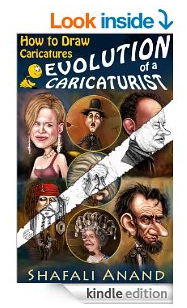…Who Goes Bang Bang this Thursday, Despite his Health Problems!
This post is the result of Hrithik’s interview that was published in today’s TOI. At the onset, I must tell you that I am not a fan of Hrithik the Bollywood Actor. In fact, I’ve seen just one movie of his (one of the Krishh’s, and I’ve forgotten which one.) And yet, now I have become one of the biggest fans of Hrithik the person behind the actor. I like brave people, and I think that bravery is an attribute of the human mind. It doesn’t depend upon anything external to a person – neither their station in life, nor their physical strength. Some people are brave, others just aren’t; they whine and cry and want the whole world to understand their problems, without ever taking the first important step, which is realizing that they are the only ones who can solve their problems and all that whining actually drives the right kind people away from them.
( Note: The above caricature was done using Toonsie Roll – A Caricaturing/Caricature-making iPhone/iPad app.)
In my estimate, Hrithik Roshan is one of the bravest celebs that clutter our waking moments. He is someone who is an inspiration to many who battle chronic illnesses and debilitating pain. Almost all his life, he has lived with excruciating pain and with bones that broke on the slightest pretext. He has been suffering from arthritis from a very young age, and when he was a teenager, his doctors had told him that he had the skeleton of an old man. He was advised against becoming an actor. In Bollywood, you can’t be a star if you don’t dance (yes, pelting your pelvis as far as you can in all directions and gyrating on the beats of a raunchy number – stuff that is really really bad for your back); or if you don’t do stunts (toss yourself up in the air with your limbs flailing and hitting ten goons at once)! So Hrithik, the boy with a spine that was proclaimed geriatric by the medicos shouldn’t have done any of what he did. Instead, he should’ve stayed home, watched dvds, ate potato-chips, grown corpulent, started a blog, and talked about how unfair life was.
But Hrithik did something different. He looked at the hand of cards that fate had dealt to him, figured out a strategy to beat the odds, and stayed in the game. Yes, he came from a fairly affluent family. Yes, he could get a doctor’s attention whenever he needed it. But nothing could’ve made him the star that he is today – nothing except his own determination to beat the odds.
So far, this year has been terrible for Hrithik. When he was shooting for Bang Bang, he got ill because there were blood-clots in his brain and he had to undergo a brain-surgery. His backache, his companion of 27 years, has been troubling him so much that he travels in a convoy of three cars, because he can’t sit in one position for more than 30 minutes. On the personal front, he has filed for a divorce from his wife, who he confirms, has not asked for an alimony of 400 Crs. (The amount sounded ridiculous any way,) and when the divorce is through he may lose the custody of his two sons to his wife. That’s a lot for anyone to handle – and yet he handles it all so well. The boy whose was advised not to be an actor, is the one who has made Roshans a recognized name in the Indian Film Industry. He’s an excellent dancer, he looks muscular in his movies, he does all those stunts that movies require him to do – and I think he is able to do it because he has a beautiful mind.
He says that he always tried being a nice person, but it didn’t work, because when you try to be nice to everyone and not hurt anyone, you try to achieve the impossible and end up hurting yourself; so you must try to be a good person instead. A good person does good whenever he or she can, but doesn’t try to please everyone. I agree – totally.
So that’s that about Hrithik. I wish him the best and I hope that he continues to win the battle that he is fighting with his illnesses. Another braveheart that I want to mention here is Shubhpreet Kaur Ghumman. This post isn’t about this one-legged brave beauty, but here’s the link to her Facebook page.
I’ll be writing a set of tutorials on How to Create Caricatures with Toonsie Roll, so do return.














